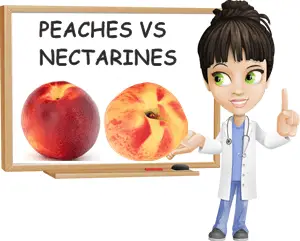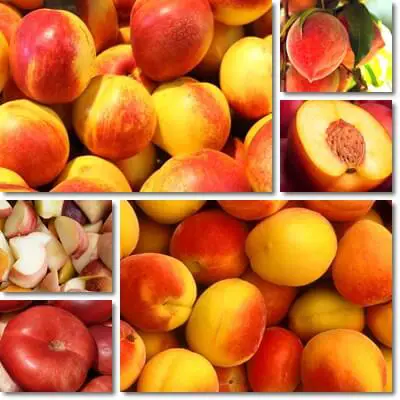What is the difference between a nectarine and a peach? Are nectarines and peaches the same thing? Are nectarines peaches? Are peaches nectarines? Are they different types of fruit? How are nectarines different from peaches? Which is healthier and better for you between nectarines and peaches?
Is a nectarine the same thing as a peach?
Commercially, nectarines and peaches are treated as different fruits and sold separately. But while they are not the exact same fruit, they are not very different either. Botanically speaking, nectarines and peaches are quite closely related, that is, nectarines are a subspecies of peach. To be more exact, nectarines arose from peaches via a natural mutation. It’s a similar situation to mandarin oranges and sweet oranges: sweet oranges arose from mandarin oranges naturally. Genetically speaking, nectarines are more or less peaches without fuzz.

What is a peach?
A peach is a roundish to heart-shaped fruit with velvety skin. The skin is red and yellow, red and white, or red-purple with yellow when ripe, while the flesh is usually either yellow or white. Botanically, peaches are related to apricots, plums, cherries, almonds, even mango, loquat, olives and coffee, and, of course, nectarines. They are classified as drupes which means stone fruit, a references to the pit or stone in the center of the fruit, essentially a hard shell with one kernel inside. The scientific name for peaches is Prunus persica.
What is a nectarine?
From a commercial standpoint, a nectarine is a fruit similar to a peach. From a botanical standpoint, a nectarine is a subspecies of peach. What this means is that nectarines are genetically related to peaches, as in they arose from peaches, but they are different enough that they cannot be classified as peaches or a variety of peach.
To mark the fact that the two fruits are related, as well as the fact that they are not the same fruit, nectarines have been given the scientific names Prunus persica var. nucipersica and Prunus persica var. nectarina. The scientific name of nectarines is the same as that of peaches, Prunus persica, with an addition that indicates it’s a different fruit from a peach, nucipersica/nectarina.
Find out more about what is a nectarine.

Nectarine vs peach: differences in appearance
One of the main reasons why nectarines and peaches can easily pass off as different fruit is because of one has a smooth skin and the other has fuzz on its skin.
This is really the biggest, most noticeable difference between the two in terms of appearance and what helps most people tell nectarines apart from peaches and vice versa. And it’s all a result of differences in one gene.
Nectarines can grow on a peach tree at any time and all it takes is for the gene that makes peaches fuzzy to become recessive, that is, not manifest. And voila: you have nectarines!
Of course, nectarines and peaches look different in other respects too, but other than the presence or absence of fuzz, the rest of the differences in appearance become close to unusable material considering there are hundreds of different varieties of the two fruit, some virtually indistinguishable from one another to the untrained eye.
For example, nectarines are said to be redder than peaches, but that is only true for specific varieties. There are plenty of peach varieties that are almost entirely red, and plenty of nectarine varieties that are more yellow than red, even completely yellow (e.g. mango nectarines). If two similar looking varieties are compared, they will look almost indistinguishable, except for the fuzz.
Other than this, both nectarines and peaches come in different sizes ranging from small to medium to large to extra large, and shapes ranging from rounded to rectangular or flat (called flat nectarines/peaches or donut nectarines/peaches). Both fruit have varieties with yellow flesh and varieties with white flesh. And both are available as clingstone, freestone and partially clingstone.
Nectarine vs peach: differences in taste
There really are no big differences in taste between nectarines and peaches. It’s not uncommon for people who are not aware that nectarines and peaches are not quite the same thing to prefer the peaches without fuzz, that is, nectarines.
On a very general not, peaches tend to have a more straightforward sweet taste, with strong, fruity flavors. Vs them, nectarines, while extremely sweet and flavorful as well, tend to be only very lightly acidic. But a lot of times that is not enough to tell the two apart.
What I’ve noticed after eating 50 or so different varieties is that, if nectarines are somewhat underripe, the flesh surrounding the pit or stone may taste slightly bitter. Also my opinion: fruit that are perfectly ripe, having had the chance to ripen on the tree almost completely, and enjoy optimal growing conditions (lots of water, good soil, plenty of sunshine), taste the best, whether they are nectarines or peaches. Fruit ripeness and optimal growing conditions can trump variety.
Nectarine vs peach: nutrition facts
There are slight differences in nutrition between nectarines and peaches, but overall insignificant in the sense that they do not impact health and nutrition status measurably. In fact, it’s possible for the same range of nutritional differences to occur between nectarines, even ones of the exact same variety, and peaches too.
Nutritional differences between fruits of the same species and variety are most often caused by factors such as growing conditions (e.g. soil quality which determines availability of nutrients to the plant) and sometimes also plant health and degree of ripeness. But overall you can substitute nectarines with peaches in your diet, and vice versa, and enjoy the same nutrition and health benefits.
What to know about nectarine and peach nutrition:
- Both nectarines and peaches are low in calories with around 40 to 50 kilocalories per 100 grams.
- Both fruit have a moderate content of carbohydrates: under 10 grams of carbs per 100 grams.
- Both fruit have a moderate sugar content: 8-9 grams of sugar per 100 grams.
- Both fruit provide small amounts of dietary fiber: around 1.5 grams of fiber per 100 grams.
- Both nectarines and peaches are modestly nutritious, providing only small amounts of most essential vitamins and minerals (an average of 3% of daily values or under for most vitamins and minerals).
- Nectarines and peaches are highest in vitamin C with an estimated 8% of daily values of vitamin C per 100 grams of fruit.
- Nectarines and peaches provide 4% of daily potassium for an adult for every 100 grams, and 5% of daily vitamin E and vitamin B3.
- Both nectarines and peaches are sodium free.
Nectarine vs peach: which is healthier?
Both nectarines and peaches are just as healthy and good for you. At the end of the day it comes down to which you prefer, if you have a preference, that is. Some of the benefits of the two fruit for health include:
- Low in calories – good food to eat in a weight loss diet or for weight management.
- Low glycemic index score – do not cause spikes in blood sugar levels. Find out what is the glycemic index of nectarines.
- Have limited effects on blood sugar and can be consumed by diabetics in reasonable amounts. Find out more about nectarines and diabetes.
- Good for skin health, helping counteract and lower inflammation of the skin thanks to a good content of vitamin B3 and vitamin E.
- Benefits for high cholesterol owed to vitamin B3 which, studies say, helps lower LDL (bad) cholesterol and improve HDL (good) cholesterol numbers.
- Good for teeth and gums due to a good content of vitamin C which actively contribute to maintaining both healthy teeth and healthy gums.
- Hydrating effect and tonic, energizing properties owed to a high water content, small amounts of B vitamins and dietary minerals, as well as a good content of natural sugars.
- High content of bioactive antioxidants, most notably pigmented anthocyanin antioxidants with scientifically proven anti-inflammatory and anticancer properties.
- Minor blood pressure lowering benefits owed to the content of potassium and magnesium in the fruit, as well as to the fruit being sodium free.
- Anti-aging benefits, longevity-promoting action.
For more info on health effects, including the anti-aging properties of the fruit, see article on the benefits of eating nectarines.
Nectarine vs peach: season
Nectarines and peaches are cultivated in the same regions and have the same season: late spring to late summer or early fall at the latest. But both fruit are available off-season as well as they are cultivated in both the Northern and the Southern hemisphere.
Both nectarine and peach trees thrive in climates with cold winters and can withstand temperatures as low as – 25 to -30 degrees Celsius, although not without consequences. Flower bud loss as well as fruit loss are common with nectarine and peach trees in temperate climates with especially harsh winters and late frosts.
Nectarine vs peach: side effects
Given they are so closely related, nectarines and peaches have about the same range of side effects. For the most part, they can cause loose stools in people whose diet is very low in dietary fiber and, in rare cases, allergic reactions. But the frequency of side effects is low and both fruit are generally safe to eat, except for cases of allergies.
